Compact representation and Strategic logic analysis adapted to circular seating reasoning puzzles
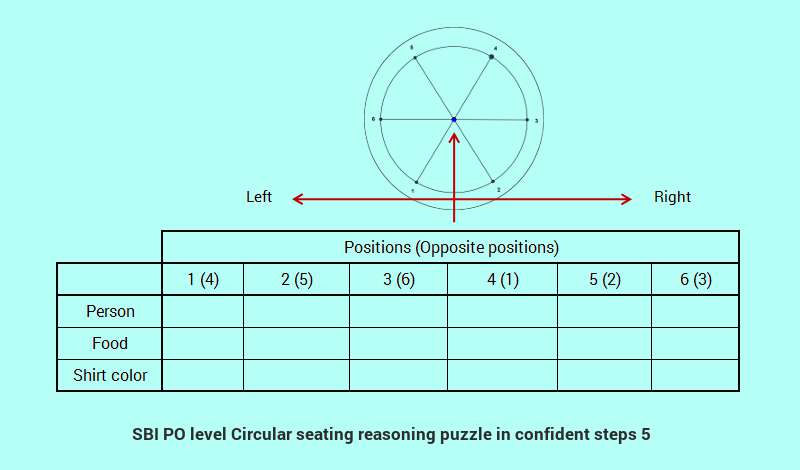
For solving high level SBI PO type Circular sitting arrangement reasoning puzzles with same ease, in this session we'd adapt the compact logic table representation and strategic logic statement execution methodology we had used in solving family relations, floor stay and other varieties of high level reasoning puzzles in earlier sessions.
Before going ahead further, you may refer to our earlier tutorial sessions,
How to solve SBI PO level logic puzzles in a few simple steps 1
How to solve SBI PO level logic puzzles in a few simple steps 2
How to solve SBI PO level family relation problems in a few simple steps 3
How to solve high level floor stay reasoning puzzles for SBI PO in a few confident steps 4
In this session we would skip the general theoretical concepts on solving assignment logic puzzles. For understanding the explanations in this session one should go through these basic concepts from the tutorials.
Characteristics of Circular sitting arrangement reasoning puzzles
In a circular sitting arrangement reasoning puzzle, assume that a group of 6 persons sit around a round table as below,
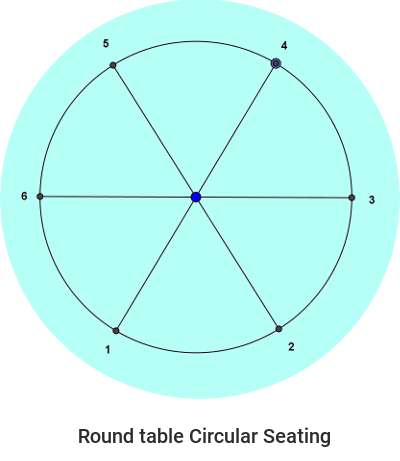
In a round table sitting arrangement, we can assume any position as the position number 1 and count each position on the right (or left) in increasing position numbers till we cover all the positions and stop on the left (on the right in case we number the positions clockwise) of position number 1. The set of linear positions from 1 to 6 is thus joined implicitly at the starting position 1 forming a loop because of the circular nature of the table.
For all practical purposes we will deal with the positions just as in a linear sitting arrangement with the small additional information that starting position 1 is on the right of ending position 6 and position 6 is on the left of position 1.
This way we will deal with the round or circular aspect of the sitting arrangement for any number of persons.
To take care of the left-right sitting relation concept, we always assume by default that the persons are facing the center of the table, that is, in a left to right representation of the linear positions 1 to 6, the persons are facing towards the north direction.
The third characteristic implicit in such puzzles is the equal distance sitting of the persons. We can properly deal with the third important attribute of Opposite positions mentioned in such puzzles only if the seats are placed at equal distances and the number of positions is even. If the number of persons is odd such opposite position aspect will be invalid.
With this brief introduction, Let us now go into the process of solving a high level circular sitting arrangement reasoning puzzle.
High level Circular sitting arrangement Reasoning Puzzle of SBI PO type
Problem description
Six persons Rup, Gaur, Rio, Tej, Vicky and Sam are sitting around a round table facing towards the center of the table in a restaurant. They have ordered for different food items viz. Idili, Dosa, Korma, Dhokla, Biriyani and Pulao, as their lunch. They are wearing shirts of different colors, viz. Green, Black, Red, White, Blue and Yellow. Food items ordered for the lunch and colors of shirts are not necessarily according to the order of their names.
Conditional statements
- The persons who have ordered Idili, Korma and Biriyani are neither in White shirt nor in Black.
- Persons who are in Green and Yellow shirts have neither ordered Idili nor Korma.
- Rup is neither in White shirt nor on the immediate left of the person who has ordered Dhokla.
- The only person who is between Vicky and Sam eats Dosa.
- The person who is on the left of the person in White shirt does not eat Pulao.
- Tej has ordered Dhokla and the color of his shirt is Green. He is facing the person who has ordered Dosa.
- One who has ordered Idili is seated opposite to the person wearing Blue shirt, while the person whose shirt is of Green color is on the left of the person who has ordered Biriyani.
- Rio has not ordered Korma while Sam has not ordered Idili.
- One who has ordered Pulao is on the immediate right of the person in White shirt but on the immediate left of the person who has ordered Korma.
Questions
Question 1. Who among the following wears Yellow shirt?
- Vicky
- Sam
- Rup
- Gaur
- Rio
Question 2. What is the color of the shirt of the person who ordered Korma?
- Black
- Red
- Green
- White
- Blue
Question 3. Which food item was ordered by the person sitting opposite to the person wearing White shirt?
- Dhokla
- Idili
- Dosa
- Pulao
- Biriyani
Question 4. Which among the following is a valid combination?
- Vicky-Dosa
- Rup-White
- Biriyani-Sam
- Idili-Red
- Pulao-Blue
Question 5. Who are sitting on two sides of Gaur?
- Vicky-Rio
- Sam-Tej
- Rio-Sam
- Sam-Rup
- Tej-Vicky
Solution to the Circular sitting arrangement Reasoning Puzzle of SBI PO type
Problem analysis and representation
We have four sets of objects all with equal number of items. The 6 persons wearing 6 different colors of shirts and having ordered six different food items are to be assigned to 6 positions on the round table. This is an one to one logic assignment problem.
We would place the six positions as the column labels 1 to 6 from left to right as we do in linear sitting puzzles. Implicit knowledge is the person in position 1 will be on the right of position 6, and person in position 6 will be on the left of position 1. The positions are placed in conventional left to right system as the persons face upwards, or northwards, in the direction of the virtual center of the round table.
Before solving the problem, we have identified the opposite pair of positions and have recorded it against the position labels so that we do not need to think much to find which position is opposite to which one. Saving time to solve of utmost importance.
The three object sets Persons, Food and Shirt color to be assigned to the six positions on one to one basis will form the three row labels.
As usual we start with three object lists on the top of the table entries, which we will go on striking off as they are assigned.
The following is the logic table representation for this problem we will work with.
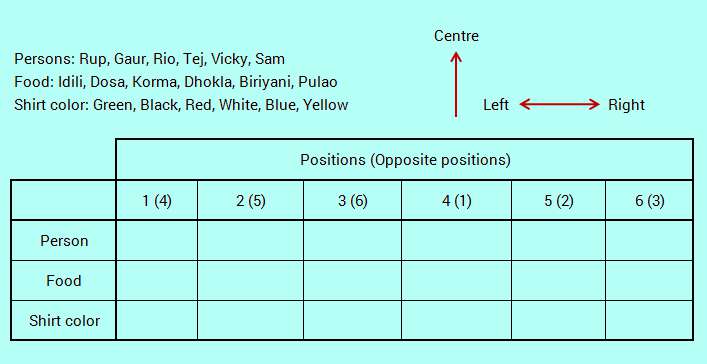
Solution Stage 1: Strategy 1: Direct assignment first strategy
We will first execute the conditional statement that directly define a relation between maximum number of members of the three object sets that are to be assigned to each position.
The interesting aspect with round table puzzle is, we can place such a person with maximum number of certain assignments in any position.
By such a Statement 6: "Tej has ordered Dhokla and the color of his shirt is Green. He is facing the person who has ordered Dosa." we will place the triple values of Tej-Dhokla-Green in position 1 just for convenience, and accordingly Dosa as food against position 4 (which is the position opposite to position 1 already recorded).
This statement thus creates 3 numbers of direct assignments of Tej-Dhokla-Green to position 1. The freedom to assign any person to any position exists only at the first step on the empty logic table. Once the first assignment is made, all the subsequent position assignments are to be specific relative to this first position.
Recommendation: At the first stage avoid processing any statement that has mention of "neither", "nor" or "or", because these inherently increases uncertainty at this stage.
Solution Stage 1: Strategy 2: Link search technique
We will now look for a statement that has any useful mention of the values assigned with maximum potential. We find such statement in Statement 4. "The only person who is between Vicky and Sam eats Dosa." which fixes "Sam/Vicky" pair of persons in two positions 3 and 5. This is where we record an uncertainty of degree two as per our Two degree uncertainty principle.
The advantage of recording entries with two-degree uncertainty is first, blocking the two positions 3 and 5, and second, in case any of this "Sam/Vicky" pair of entries is resolved to a single certain assignment at a later stage, the other position also gets assigned with certainty automatically.
The following is the logic table after execution of these two statements according to our methodology of such puzzle solution.
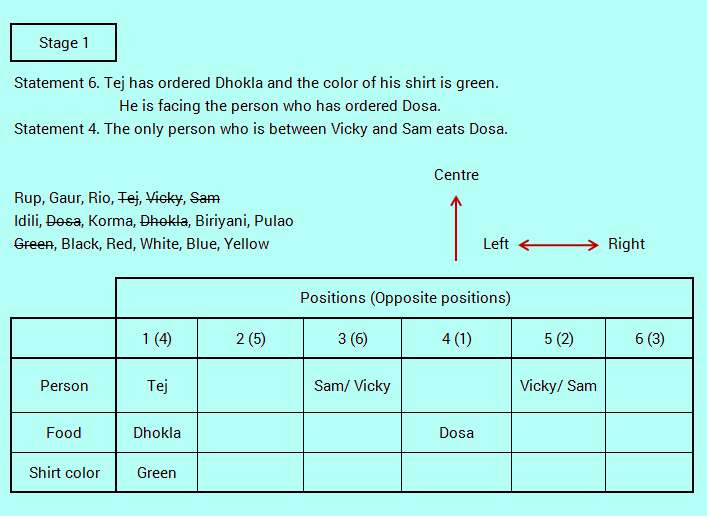
Solution Stage 2: Strategy 3: Fitting a bonded member structure into the logic table
By a statement occasionally two or three horizontally related (in this type of horizontal position assignment problems) to be assigned members, form what we call a bonded member structure. Whatever be the position of such a structure in the logic table, the relative positions of the members in the structure is fixed by such a logic statement.
Such bonds being highly useful especially in later stages of logic assignment, we search for such a fixed relation set now and find it in Statement 9."One who has ordered Pulao is on the immediate right of the person in White shirt but on the immediate left of the person who has ordered Korma." Three positions in sequence are bound by the statement as below,
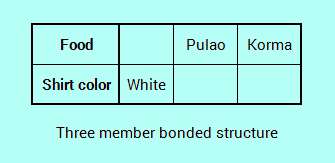
When we try to place this fixed relation structure of three members, we find only one possible placement of Pulao-Korma pair in position 5 and 6. Pulao-Korma food pair cannot be assigned to the only other vacant positions 2 and 3 because of Shirt color conflict with Tej at position 1.
The logic table now looks like,
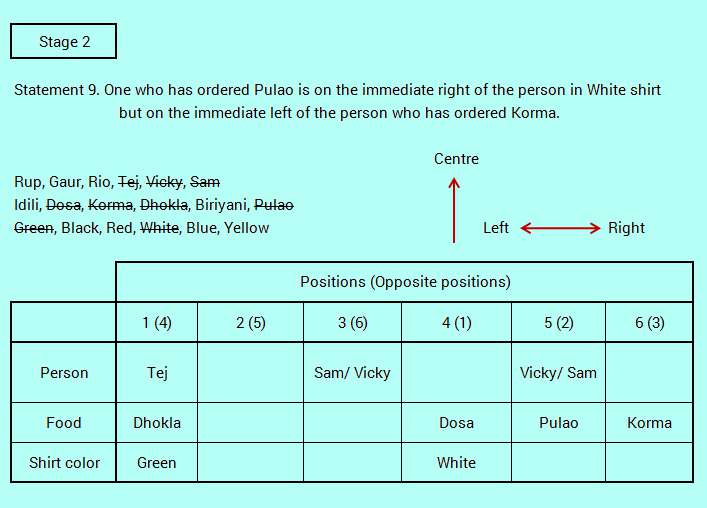
Solution Stage 3: Strategy 4: Link Search technique with Exclusion applied on maximum assigned (filled up) row
We will focus our attention on the row with maximum cells filled up, and try to find statements that enable rest of the two cells to be assigned. Chances of this will be higher because we would have to eliminate just one possibility to have a certainty on the other for Food row.
This will be the general overarching strategy all the time. This strategy is driven by the general problem solving principle of maximum promise option.
Specifically, to execute the strategy with fruitful results, we take help again of never failing strategy of link search technique. At every stage we always look for an opportunity to apply this very useful technique.
You will notice that this time the main strategy is not a simple one, but a compound type with one strategy within another. This happens in any significant real life and academic problem.
Thus according to this compound type strategy we select Statement 7: "One who has ordered Idili is seated opposite to the person wearing Blue shirt, while the person whose shirt is of Green color is on the left of the person who has ordered Biriyani.". In this statement, especially the second part attracts our attention as it refers to already assigned Green color. This enables us immediately to assign food Biriyani to position 2.
Now it is the turn to apply principle of exclusion and the remaining food Idili is assigned to position 3.
Interestingly only after this assignment we can put color Blue to position 6 by the first part of the statement 7.
The second part of the Statement 7 is executed first by link search technique and that resulted in two consecutive positive results. These are the gains in following effective strategic methodology.
Taking this opportunity of fully assigned foods we take up next Statement 8. "Rio has not ordered Korma while Sam has not ordered Idili.". More so because it refers to Sam, an already assigned value even if it is with two degree uncertainty. This again is use of link search technique.
If we had attempted to use this statement earlier, it won't have produced a very useful result, but now, as the foods are completely known, and the first part of the Statement 8 refers to foods only, Statement 8 first clearly resolves Sam at position 5 (and so Vicky at position 3) because of conflict at position 2 (principle of conflict working). The first part of the statement 8 then enables us to put Rio at position 2 and 4, a two degree allowable uncertainty.
The logic table at this stage is shown below.
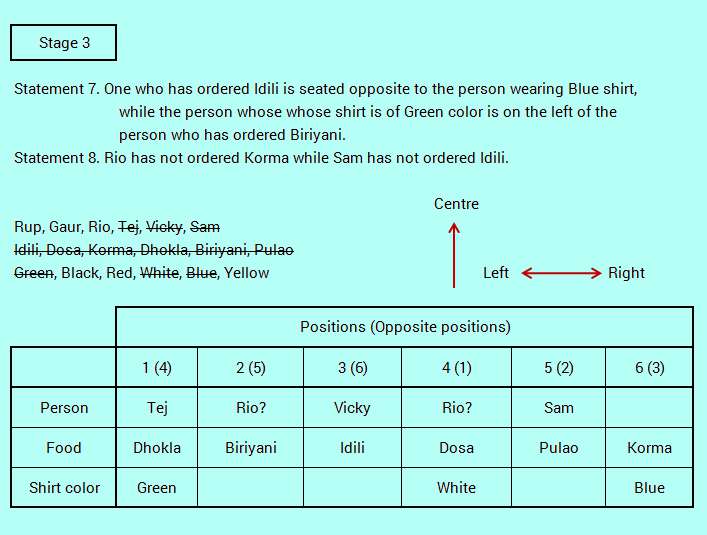
Solution Stage 4: Strategy 5: Principle of conflict
With foods completely filled up and other two rows (object sets) also well filled up, we will automatically look for conflicts to result in a certain assignment. In Statement 3: "Rup is neither in White shirt nor on the immediate left of the person who has ordered Dhokla." , we get two such conflicts resulting in a certain assignment of Rup to position 2, which further removes one of the uncertainties of Rio and finalizes his position to position 4. By exclusion Gaur is assigned to position 6.
All foods and all persons are now assigned.
The logic table condition is as below,
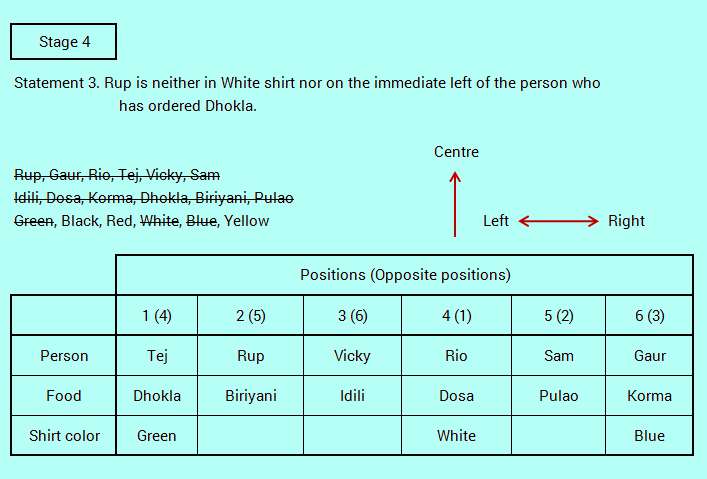
Solution Stage 5: Strategy 5: Principle of conflict
Out of the two remaining statements we choose Statement 2. "Persons who are in Green and Yellow shirts have neither ordered Idili nor Korma.", because it is not only the simpler of the two remaining statements, but also results in an allowable two degree uncertain assignment of Yellow in position 2 and position 5.
Verify this step yourself.
The corresponding logic table is as below,
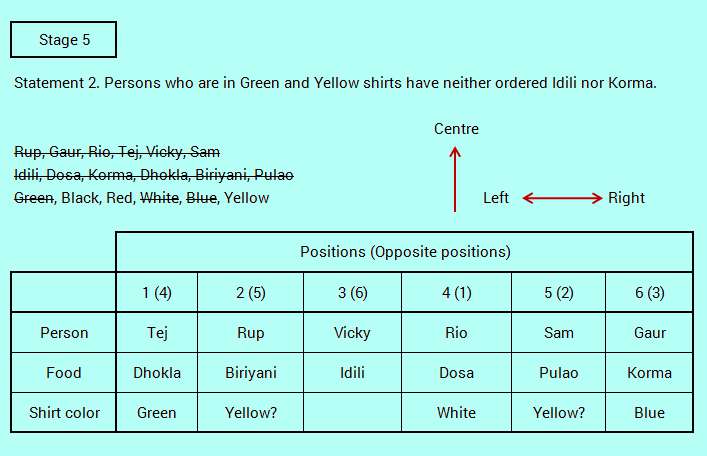
Solution final Stage 6: Strategy 6: Compound statement simplification
It is good that we have to execute the most complex Statement 1. "The persons who have ordered Idili, Korma and Biriyani are neither in White shirt nor in Black." with maximum uncertainty creating potential, at the last.
Let us explain its resolution in this final stage.
We are concerned with shirt color in positions 2, 3 and 5. Color White and food Korma are already assigned. So we disregard the Korma clause applicable for position 6, as well as color White applicable for position 4 straightaway. The changed simpler statement 1 is now,
"The persons who have ordered Idili, and Biriyani are not in Black."
We can process this either way. Taking the first path we consider the possible colors for Idili position as Black and Red, out of which Black is disallowed by this last statement. So Red goes to position 3.
By the same reasoning on position 2, Black gets disallowed, and uncertain Yellow for this position becomes certain.
The last color Black goes to position 5 by exclusion.
The final fully assigned logic table is then,
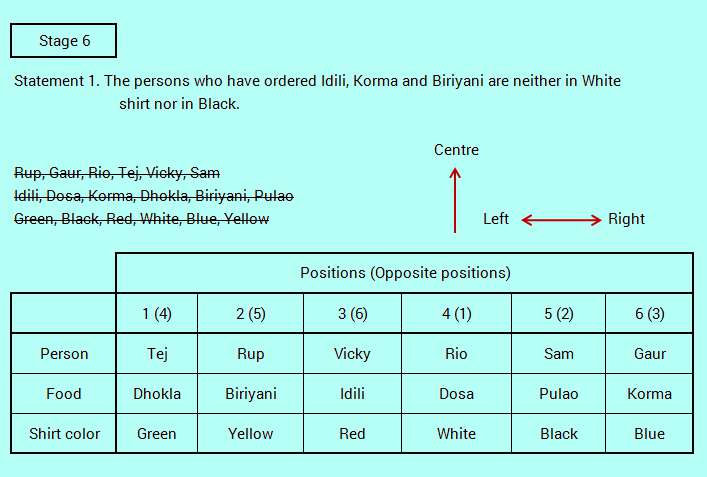
Now we are ready to answer the questions and it should take only about a minute's time to answer the five questions.
Answers to the questions
Question 1. Who among the following wears Yellow shirt?
Answer 1. Option 3: Rup.
Question 2. What is the color of the shirt of the person who ordered Korma?
Answer 2. Option 5: Blue.
Question 3. Which food item was ordered by the person sitting opposite to the person wearing White shirt?
Answer 3. Option 1: Dhokla.
Question 4. Which among the following is a valid combination?
Answer 4. Option 4: Idili-Red.
Question 5. Who are sitting on two sides of Gaur?
Answer 5. Option 2: Sam-Tej.
Comment
The compact representation of logic table is important, but critical is the ability to choose the most efficient sequence of executing the logic statements. That is possible only by a well-developed strategy based logic analysis methodology.
To be comfortable with such puzzle solving of any structure and type, there is no alternative other than solving many problems of various types and always analyzing how the puzzle was solved.
End note
Solving reasoning puzzles does not need knowledge on any subject—it is just identifying useful patterns by analysis of the problem and using appropriate methods. It improves problem solving skill, because patterns and methods lie at the heart of any problem solving.
Other resources for learning how to discover useful patterns and solve logic analysis problems
Einstein's puzzle or Einstein's riddle
The puzzle popularly known as Einstein's puzzle or Einstein's riddle is a six object set assignment logic analysis problem. Going through the problem and its efficient solution using collapsed column logic analysis technique in the session Method based solution of Einstein's logic analysis puzzle whose fish should be a good learning experience.
Playing Sudoku
As a powerful method of enhancing useful pattern identification and logic analysis skill, play Sudoku in a controlled manner. But beware, this great learning game, popularly called Rubik's Cube of 21st Century, is addictive.
To learn how to play Sudoku, you may refer to our Sudoku pages starting from the very beginning and proceeding to hard level games.
Reading list on SBI PO and Other Bank PO level Reasoning puzzles
Tutorials
How to solve SBI PO level logic puzzles in a few simple steps 1
How to solve SBI PO level logic puzzles in a few simple steps 2
How to solve SBI PO level family relation problems in a few simple steps 3
How to solve SBI PO level floor stay Reasoning Puzzle in a few confident steps 4
How to solve high level circular seating reasoning puzzles for SBI PO in confident steps 5
How to solve high level hard two row seating reasoning puzzles for SBI PO in confident steps 6
How to solve high level circular seating arrangement reasoning puzzles for SBI PO quickly 7
How to solve high level nine position circular seating easoning puzzles for SBI PO quickly 8
How to solve high level box positioning reasoning puzzle for SBI PO quickly 9
Solved reasoning puzzles SBI PO type
SBI PO type high level floor stay reasoning puzzle solved in a few confident steps 1
SBI PO type high level reasoning puzzle solved in a few confident steps 2
SBI PO type high level reasoning puzzle solved in a few confident steps 3
SBI PO type high level circular seating reasoning puzzle solved in confident steps 4
SBI PO type high level hard reasoning puzzle solved in confident steps 5
SBI PO type high level one to many valued group based reasoning puzzle solved in confident steps 6
SBI PO type high level hard two in one circular seating reasoning puzzle solved in confident steps 7
SBI PO type hard facing away circular seating reasoning puzzle solved in confident steps 8
SBI PO type high level four dimensional reasoning puzzle solved in confident steps 9
SBI PO type hard two row seating reasoning puzzle solved in confident steps 10
SBI PO type high level floor stay reasoning puzzle solved in confident steps 11
Solved Reasoning puzzle of Bank PO type
Bank PO type two row hybrid reasoning puzzle solved in confident steps 1
Bank PO type four variable basic assignment reasoning puzzle solved in a few steps 2
Bank PO type basic floor based reasoning puzzle solved in a few steps 3
Bank PO type high level floor stay reasoning puzzle solved in quick steps 4
